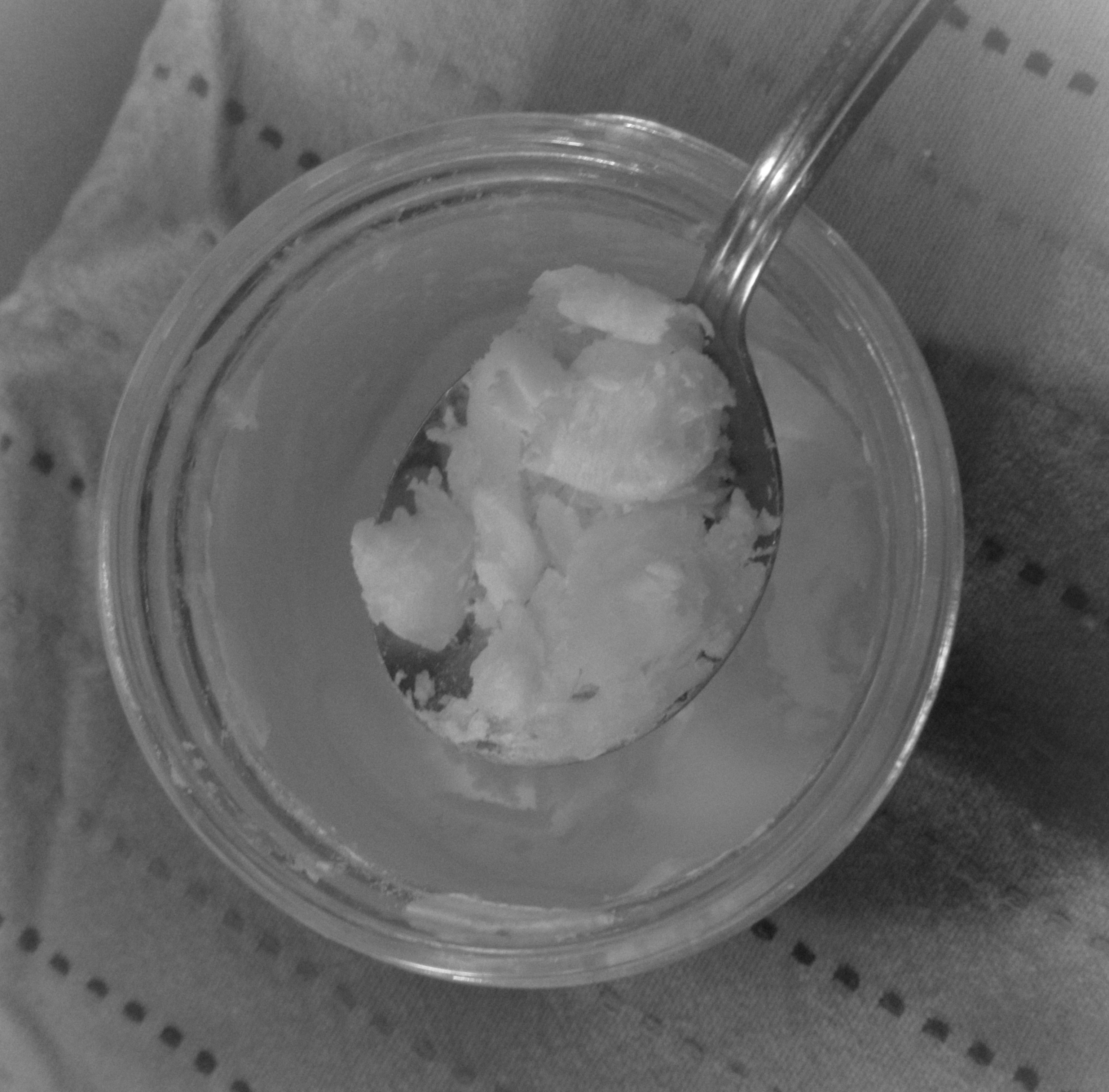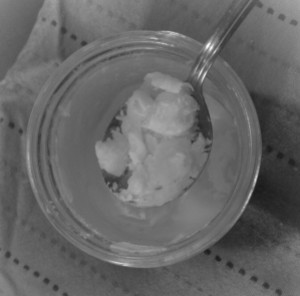Morning Thunder (whose origins and recipe I previously wrote about) is a root tea mix with a great deal of healing properties: gut-healing, anti-inflammatory, 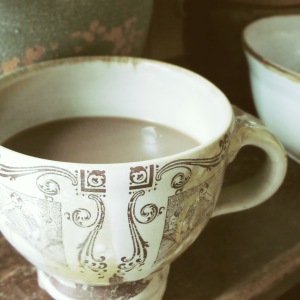 diuretic, alterative, adaptogenic, stimulating but calming, liver supporting. I am not going to go into licorice, ginger, cacao, burdock, or cinnamon, as its highly likely I will cover those herbs at other times, and I’m just so darn excited to share some of the superpowers of these other herbal action heroes.
diuretic, alterative, adaptogenic, stimulating but calming, liver supporting. I am not going to go into licorice, ginger, cacao, burdock, or cinnamon, as its highly likely I will cover those herbs at other times, and I’m just so darn excited to share some of the superpowers of these other herbal action heroes.
Chicory (Cichorium intybus)
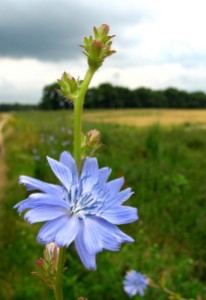 Cultivated in ancient Egypt for food and medicine, chicory has long been a staple of coffee-like beverages for good reason (http://www.smithsonianmag.com/arts-culture/chicory-coffee-mix-new-orleans-made-own-comes-180949950/?no-ist). This wild abundant perennial has a long taproot which, when roasted, offers a rich flavor and texture, as well as inulin (a prebiotic polysaccharide), esculin, coumarins, flavanoids, and vitamins. Ethyl root extracts of chicory have been found to be antimicrobial against a variety of gram positive and gram negative bacteria, including Bacillus subtilis, Staphylococcus aureus and Salmonella typhi.
Cultivated in ancient Egypt for food and medicine, chicory has long been a staple of coffee-like beverages for good reason (http://www.smithsonianmag.com/arts-culture/chicory-coffee-mix-new-orleans-made-own-comes-180949950/?no-ist). This wild abundant perennial has a long taproot which, when roasted, offers a rich flavor and texture, as well as inulin (a prebiotic polysaccharide), esculin, coumarins, flavanoids, and vitamins. Ethyl root extracts of chicory have been found to be antimicrobial against a variety of gram positive and gram negative bacteria, including Bacillus subtilis, Staphylococcus aureus and Salmonella typhi.
The herb and nutrition markets have paid much attention to inulin. a starch-like polysaccharide used as energy reserve by many plants, including artichokes, salsify, and garlic. In the food industry, inulin has become multi-purpose, substituting as a low-glycemic diabetic-friendly sweetener in the place of sucrose, as a substitute for fat and flour, and as a soluble fiber. In my opinion, the place inulin is most visible on the market is as a pre-biotic additive to cultured dairy products. Research has show the ingesting moderate quantities of inulin can significantly and beneficially impact bifidobacteria in the intestine, which in turn can increase the body’s ability to absorb minerals like calcium. Professor Robert Wilson, a PhD in soil science and agronomy who has spent the past decade studying chicory at the University of Nebraska, notes that “the chemical bonds between these fructose units [in Chicory] are not digestible by digestive enzymes in the small intestine, but they are fermented by colonic bacteria.”
In the second century, Galen named chicory a “friend of the liver,” and subsequent herbalists and researchers have shown this bitter-flavored herb useful in treating jaundice, the flow of bile, and gallstones. Basal leaves, when young and tender in the spring, can be added to salads for minerals and that fresh bitter flavor — many cultures eat chicory leaves as a spring blood-cleansing tonic. Many edible cultivars have been developed over the centuries from wild chicory, including radicchio and Belgian endive.
My favorite thing about chicory is the particular blue of its flowers, which can often be found in abundance standing tall by the side of the road. Y’all probably know this, but just a reminder: when wild harvesting root or leaf, make sure, if possible, to find an area far from the road or industry, to ensure clean food and medicine.
He Shou Wu (Polygonum multiflorum)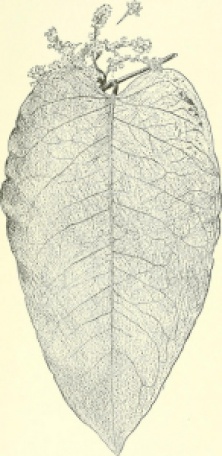
Sometimes you can tell an herb’s fame and celebrity from the sheer number of names it has earned: Fo-Ti, Mr. Wu’s Black Hair, Chinese Knotweed, Flowery Knotweed.
In the Chinese materia medica, He Shou Wu is a much-touted tonic. For more than 3,000 years, people have found this adaptogenic “elixir of life” to have a stimulating, warming, and fortifying effect on a variety of body and energetic systems. A cursory glance through any article on the subject with refer you to a host of stories featuring vigorous long-lived men who, although once susceptible to weakness and aging, experienced improved sexual vitality and hair turning from gray to black upon regular use of this herb.
Much research has examined the why and wherefore of this herb’s touted history. The root of this viney and knobby plant is rich in zinc and iron, increasing energy without being a stimulant, offering a calm focus and increased circulation, which may also be one reason is can support sexual function.
The unprocessed root of He Shou Wu is referred to as white Fo-Ti, is used to relax the bowels and detoxify the blood, can cause diarrhea, and should not be used as a tonic. The processed root, or red Fo-Ti, is made from being boiled in black bean liquid, and is considered superior tonic vitality medicine, energizing the kidneys and liver and strengthening the blood. Processed He Shou Wu contains protein-sugar complexes, lectins, which help to reduce lipids in the blood. Lectins are able to attach to specific arrangements of carbohydrates and act like antibodies, prevents the formation of vascular plaque, which in turns may prevent or delay heart disease.
Other research shows that Polygonum multiflorum has a significant impact on the levels of superoxide dismutase (SOD) activity. SOD is a powerful endogenous antioxidant and free radical scavenger that has been shown to have beneficial effects in human conditions associated with aging. Studies show He Shou Wu to improve cardiovascular function, enhance immunity, slow glandular degeneration, increase antioxidant activity, reduce the accumulation of lipid peroxidation. strengthen the membranes of red blood cells, and induce human production of g-interferon.
Marshmallow (Althea officinalis)
Goopy, star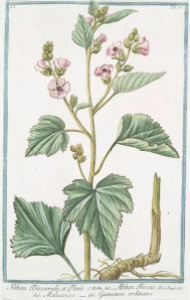 chy, sweet, marshmallow has long been used to soothe irritation in the mucous membranes, especially in the respiratory, gastrointestinal, and urinary tracts for hot and dry conditions. This demulcent quality lays a cooling film over hot and irritated tissues internally, allowing the other constituents time and access to the area to enact anti-inflammatory and immuno-modulating effects. Externally, the same soothing mucilage is considered emollient, soothing tissues irritated from wounds, burns, and a variety of dermatitis — some research has even found the herb to assist in the turnover of epithethial cells.
chy, sweet, marshmallow has long been used to soothe irritation in the mucous membranes, especially in the respiratory, gastrointestinal, and urinary tracts for hot and dry conditions. This demulcent quality lays a cooling film over hot and irritated tissues internally, allowing the other constituents time and access to the area to enact anti-inflammatory and immuno-modulating effects. Externally, the same soothing mucilage is considered emollient, soothing tissues irritated from wounds, burns, and a variety of dermatitis — some research has even found the herb to assist in the turnover of epithethial cells.
The immune-stimulating capacities of this herb in the aforementioned body systems have earned it a good reputation for respiratory infections (bronchitis, asthma, emphysema), gut conditions (ulcers and inflammatory bowel conditions), and urinary tract infections. Also helpful in renal issues is marshmallow’s ability to assist in balancing fluid/salt balance in the body, including dehydration and fluid retetion often indicated by frequent urination and thirst. The many compounds extracted from this root include pectins, starches, mono and di-saccharide sacchorose, mucilage, flavanoids, isoquercitrin, coumarins, phytosterols, tannins, asparagine, and many amino acids.
Research has confirmed the traditional uses for this herb, describing antimicrobial, antiinflammatory, antioxidant, demulcent, antitussive, and immunomodulating. With nearly 70% of the nervous system tissue occuring in the gut, this is herb is of particular us in gut inflammation or nervousness associated upset stomach, poor digestion, autoimmune digestive disorders, and mental health situations that seems to effect the gut. Immunologically, Marshmallow root appears to increase the rate at which Macrophage cells both kill and eat bacterial bodies, and neutrophils, which are recruited to the site of infection via the blood, also show increased phagocytic (cell eating!) activity.
Marshmallow is often paired with other herbs in formulas. My teacher, Paul Bergner, recommend for optimal get demulcent activity that Marshmallow root be combined with slippery elm, plantain, and licorice for acute inflammatory gut conditions.
The demulcent and emollient effects of this herb are best gained through water extraction. Hot water tends to pull out starches better, whereas cool water infusions draw the mucilage. Cold marshmallow infusions taste lightly sweetened and refreshing. Sometimes, I will infuse the marshmallow cold overnight, and then add that to the decocting process with the rest of my herb mix the next day.
White Peony Root (Paeonia lactiflora)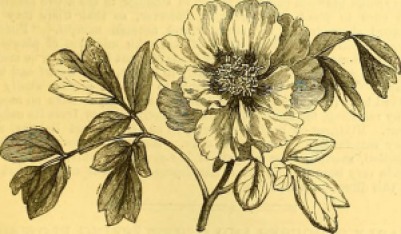
While peony is not as commonly used in the western herbal materia medicae, Japanese and Chinese medicine traditions both make frequent use of this herb in formulas. A particular formula made of peony and licorice, Shakuyaku-kanzo-to, has been studied for its efficacy in relieving muscle cramps relating to diabetes, dialysis, and cirrhosis of the liver, and has been approved by the Japanese Ministry of Health and Welfare for muscle spasm in these situations. Another Japanese formulation known as Toki-shakuyaku-san, a Japanese formula combining peony root with dong quai and several other herbs has been used effectively as an antispasmodic and analgesic in cases of dysmenorrhea.
When I studied at NAIMH, I learned to think of white peony root as a relaxant with particular affinity for the pelvis. The gentle nervine with anti-spasmodic qualities also can exert mild estrogenic effects make this herb idea for tying together formulas involving heat, inflammation, cramping, stagnancy, androgen dominance, and other gynecological, nervous, musculoskeletal, and gastrointestinal conditions. Animal studies suggest that peony extracts (which contain the unique glycoside paeoniflorin as well as proanthocyanidins, flavonoids, tannins, and polysaccharides) also elevate cognitive function, which has led researchers and herbalists to wonder about peony’s potential use in dementia.
The study of fats has been a fascinating rollercoaster of science and food chemistry in the past half century. Recently, one of my family members called me on the phone to ask, “Do you know why my doctor told me to eat a tablespoon of coconut oil every day?” This isn’t a practice I’ve ever done myself or advised any of my clients to do, but I was intrigued.
Coconut oil, as you may have observed, has been making a comeback. In the dietary fat-phobic past several decades, all saturated fats were villainized as vessel-clogging harbingers of heart disease and early death, and we now know what we may have been intuiting all along: that the quality and origin of the fat is what matters most, not the saturation.
Coconut oil is higher in saturated fats than any other non-hydrogenated oil. Saturated fats are solid at room temperature, which makes them makes it stable, offering a long shelf-life that resists rancidity, which can contribute to cardiovascular oxidative stress. Partially or fully hydrogenated oils are not solid at room temperature, have undesirable ration of omegas 3, 6, and 9, and are much more likely to go rancid and produce oxidation — a process which produces free radicals, inflammation, and tissue damage — in the body.
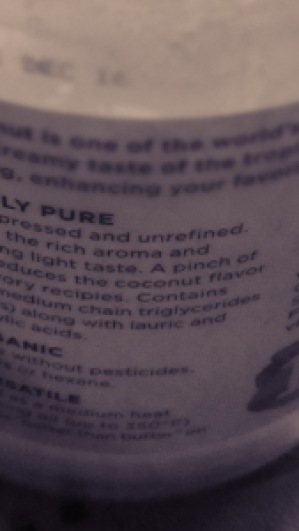 Another particular characteristic of coconut oil is that it contains a high percentage of medium-chain triglycerides, or MCTs. MCTs are between 6 and 12 carbons long, while LCTs, or long-chain triglycerides, are more than 12 carbons long. Our bodies metabolize MCTs differently from LCTs. MCTs travel directly from the intestine to the liver to be burned as fuel. This quick conversion of fats to energy elevates the metabolism slightly, avoids elevating blood serum lipid levels, and avoids depositing fats in storage tissues. MCTs are also thought to be more easily digested, help in the absorption of calcium, and are beneficial in digestive disorders, diabetes, viral infections such as mononucleosis and herpes. Many oils are made up of mostly or entirely long-chain triglycerides, such as soybean oil (100% LCTs), while coconut oil is heavier on the mediucm-chain triglycerides, approximately 40% LCTs and 60% MCTs.
Another particular characteristic of coconut oil is that it contains a high percentage of medium-chain triglycerides, or MCTs. MCTs are between 6 and 12 carbons long, while LCTs, or long-chain triglycerides, are more than 12 carbons long. Our bodies metabolize MCTs differently from LCTs. MCTs travel directly from the intestine to the liver to be burned as fuel. This quick conversion of fats to energy elevates the metabolism slightly, avoids elevating blood serum lipid levels, and avoids depositing fats in storage tissues. MCTs are also thought to be more easily digested, help in the absorption of calcium, and are beneficial in digestive disorders, diabetes, viral infections such as mononucleosis and herpes. Many oils are made up of mostly or entirely long-chain triglycerides, such as soybean oil (100% LCTs), while coconut oil is heavier on the mediucm-chain triglycerides, approximately 40% LCTs and 60% MCTs.
The antimicrobial activity of coconut oil is particularly magical to me. The free fatty acids break down the lipid membranes of pathogens without harming the digestive membranes or beneficial gut bacteria. This prevents free radical damage, rather than causing it. Dr. Mary Enig, phD. and co-author of Nourishing Traditions along with Sally Fallon, has lectured widely on the benefits of coconut oil. (http://coconutoil.com/coconut_oil_21st_century/) She writes,
“Until now, no one in the mainstream nutrition community seems to have recognized the added potential of antimicrobial lipids in the treatment of HIV-infected or AIDS patients. These antimicrobial fatty acids and their derivatives are essentially nontoxic to man; they are produced in vivo by humans when they ingest those commonly available foods that contain adequate levels of medium-chain fatty acids such as lauric acid. According to the published research, lauric acid is one of the best “inactivating” fatty acids, and its monoglyceride is even more effective than the fatty acid alone [. . .] The lipid-coated (envelope) viruses are dependent on host lipids for their lipid constituents. The variability of fatty acids in the foods of individuals as well as the variability from de novo synthesis accounts for the variability of fatty acids in the virus envelope and also explains the variability of glycoprotein expression, a variability that makes vaccine development more difficult. Monolaurin does not appear to have an adverse effect on desirable gut bacteria, but rather on only potentially pathogenic microorganisms.”
So how could you take a tablespoon of coconut oil daily? If it sounds unappealing to you to spoon it right out of the jar into your mouth, stir your coconut oil into your Morning Thunder, drizzle it over your omelet, or spread it on your toast. Or write back with your favorite ways to take your coconut oil!
RESOURCES
http://weedscience.unl.edu/pdfarticles/2013ChicoryRW.pdf
http://www.ncbi.nlm.nih.gov/pmc/articles/PMC3108611/
http://www.itmonline.org/arts/peony.htm
http://coconutoil.com/coconut_oil_21st_century/#sthash.7PkGmG7R.dpuf
http://www.sciencebasedmedicine.org/coconut-oil/
http://www.nutrition.org/asn-blog/2009/07/coconut-oil/
http://coconutoil.com/mary_enig/
http://www.westonaprice.org/health-topics/a-new-look-at-coconut-oil/
http://www.foodinsight.org/CoconutOilAndHealth
http://www.sphinxsai.com/2013/JulySept13/phPDF/PT=57%281378-1385%29JS13.pdf
http://umm.edu/health/medical/altmed/herb/marshmallow
http://academicjournals.org/article/article1381316156_Shah.pdf
http://www.academicjournals.org/journal/JMPR/article-abstract/BD00EAD40178
http://herbal-diary.com/marsh-mallow-khatmi-gul-kheri-althea-rosea-athea-officinalis/
http://www.stemcellnutrition.net/he-shou-wu
https://www.hyperionherbs.com/benefits-of-he-shou-wu/
http://www.uofmhealth.org/health-library/hn-2092003
